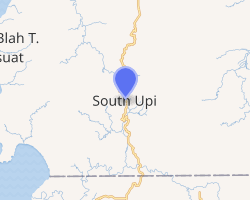South Upi
South Upi, officially the Municipality of South Upi (Maguindanaon: Ingud nu South Upi; Iranun: Inged a South Upi; Tagalog: Bayan ng South Upi), is a 4th class municipality in the province of Maguindanao, Philippines. According to the 2015 census, it has a population of 40,178 people.[3]
South Upi | |
|---|---|
| Municipality of South Upi | |
 Map of Maguindanao with South Upi highlighted | |
OpenStreetMap 
| |
.svg.png) South Upi Location within the Philippines | |
| Coordinates: 6°51′17″N 124°08′39″E | |
| Country | |
| Region | Bangsamoro Autonomous Region in Muslim Mindanao (BARMM) |
| Province | Maguindanao |
| District | 1st District |
| Barangays | 11 (see Barangays) |
| Government | |
| • Type | Sangguniang Bayan |
| • Mayor | Reynalbert O. Insular |
| • Vice Mayor | Imelda B. Estorninos |
| • Congressman | Esmael G. Mangudadatu |
| • Electorate | 25,971 voters (2019) |
| Area | |
| • Total | 184.80 km2 (71.35 sq mi) |
| Population (2015 census)[3] | |
| • Total | 40,178 |
| • Density | 220/km2 (560/sq mi) |
| • Households | 7,418 |
| Economy | |
| • Income class | 4th municipal income class |
| • Poverty incidence | 48.47% (2015)[4] |
| • Revenue (₱) | 88,848,638.77 (2016) |
| Time zone | UTC+8 (PST) |
| ZIP code | 9603 |
| PSGC | |
| IDD : area code | +63 (0)64 |
| Climate type | tropical climate |
| Native languages | Maguindanao Tiruray Tagalog |
| Website | www |
It also known as Timanan.
Barangays
South Upi is politically subdivided into 11 barangays.
- Kuya
- Biarong
- Bongo
- Itaw
- Kigan
- Lamud
- Looy/Santa Fe
- Pandan
- Pilar
- Romangaob (Poblacion)
- San Jose
Climate
| Climate data for South Upi, Maguindanao | |||||||||||||
|---|---|---|---|---|---|---|---|---|---|---|---|---|---|
| Month | Jan | Feb | Mar | Apr | May | Jun | Jul | Aug | Sep | Oct | Nov | Dec | Year |
| Average high °C (°F) | 31 (88) |
32 (90) |
32 (90) |
32 (90) |
31 (88) |
29 (84) |
29 (84) |
29 (84) |
30 (86) |
30 (86) |
30 (86) |
31 (88) |
31 (87) |
| Average low °C (°F) | 21 (70) |
21 (70) |
21 (70) |
23 (73) |
23 (73) |
23 (73) |
23 (73) |
23 (73) |
23 (73) |
23 (73) |
23 (73) |
22 (72) |
22 (72) |
| Average precipitation mm (inches) | 30 (1.2) |
19 (0.7) |
25 (1.0) |
24 (0.9) |
64 (2.5) |
88 (3.5) |
102 (4.0) |
105 (4.1) |
76 (3.0) |
82 (3.2) |
60 (2.4) |
26 (1.0) |
701 (27.5) |
| Average rainy days | 9.8 | 8.5 | 11.3 | 11.9 | 21.6 | 23.9 | 24.1 | 24.5 | 20.9 | 21.8 | 16.8 | 11.8 | 206.9 |
| Source: Meteoblue [5] | |||||||||||||
Demographics
| Year | Pop. | ±% p.a. |
|---|---|---|
| 1980 | 11,463 | — |
| 1990 | 20,293 | +5.88% |
| 1995 | 23,186 | +2.53% |
| 2000 | 28,186 | +4.28% |
| 2007 | 32,014 | +1.77% |
| 2010 | 35,990 | +4.35% |
| 2015 | 40,178 | +2.12% |
| Source: Philippine Statistics Authority[3][6][7][8] | ||
References
- "Municipality". Quezon City, Philippines: Department of the Interior and Local Government. Retrieved 31 May 2013.
- "Province: Maguindanao". PSGC Interactive. Quezon City, Philippines: Philippine Statistics Authority. Retrieved 12 November 2016.
- Census of Population (2015). "ARMM – Autonomous Region in Muslim Mindanao". Total Population by Province, City, Municipality and Barangay. PSA. Retrieved 20 June 2016.
- "PSA releases the 2015 Municipal and City Level Poverty Estimates". Quezon City, Philippines. Retrieved 12 October 2019.
- "South Upi, Maguindanao : Average Temperatures and Rainfall". Meteoblue. Retrieved 19 January 2019.
- Census of Population and Housing (2010). "ARMM – Autonomous Region in Muslim Mindanao". Total Population by Province, City, Municipality and Barangay. NSO. Retrieved 29 June 2016.
- Censuses of Population (1903–2007). "ARMM – Autonomous Region in Muslim Mindanao". Table 1. Population Enumerated in Various Censuses by Province/Highly Urbanized City: 1903 to 2007. NSO.
- "Province of Maguindanao". Municipality Population Data. Local Water Utilities Administration Research Division. Retrieved 17 December 2016.
External links
This article is issued from Wikipedia. The text is licensed under Creative Commons - Attribution - Sharealike. Additional terms may apply for the media files.